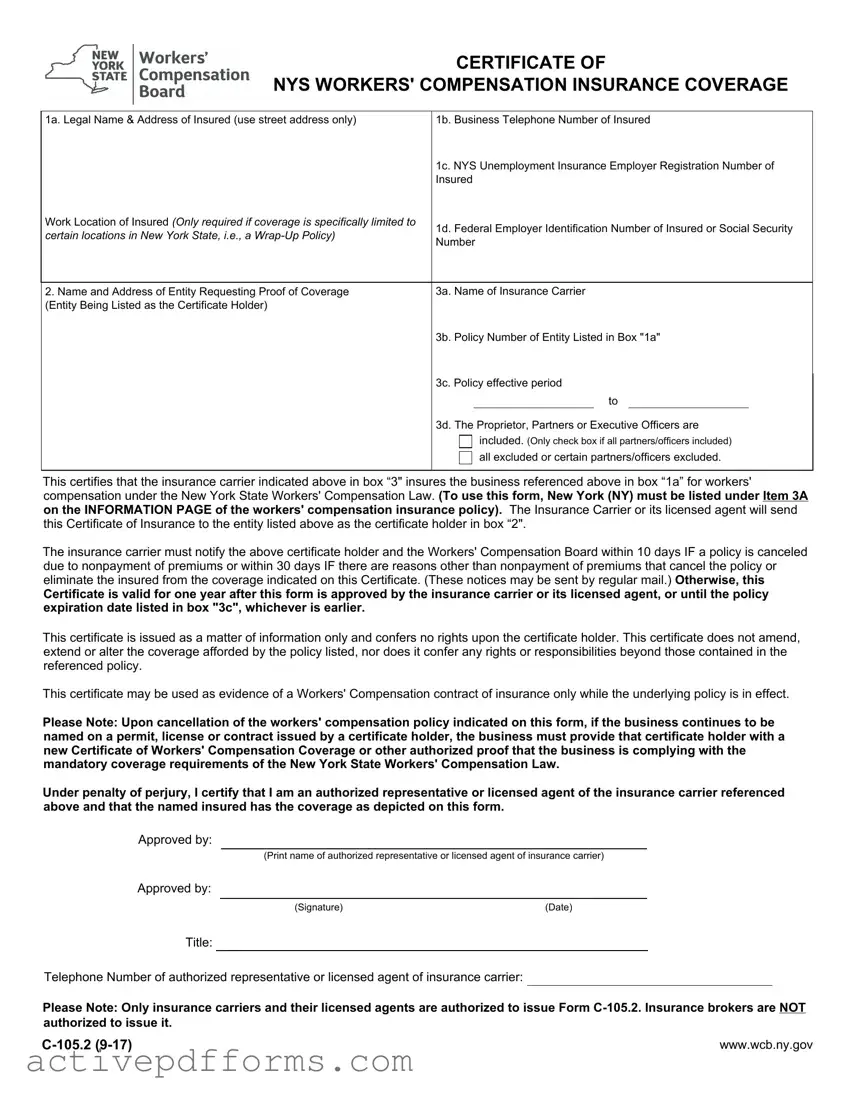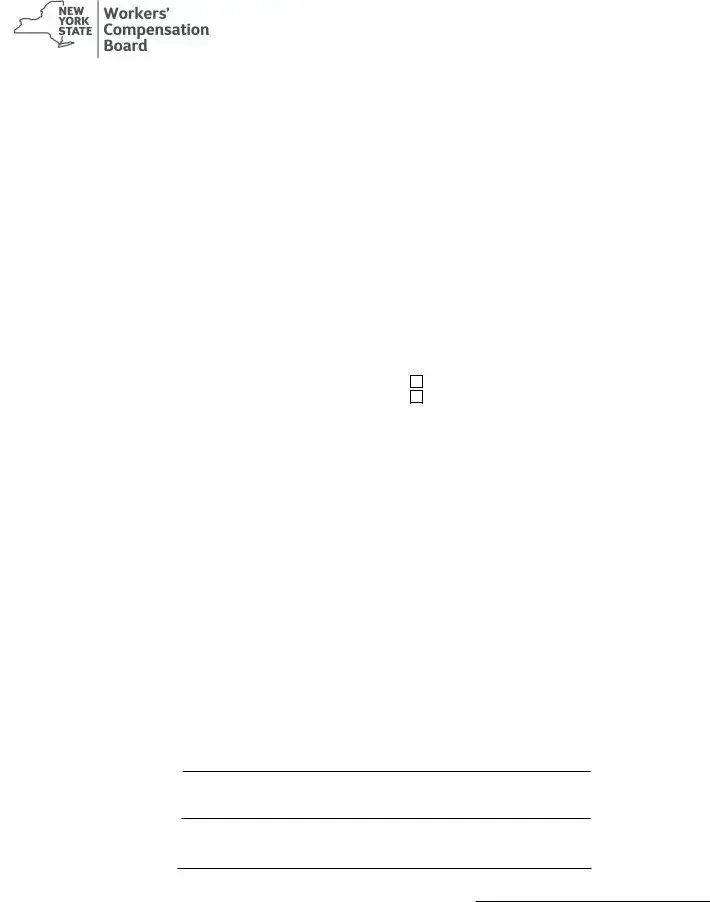CERTIFICATE OF
NYS WORKERS' COMPENSATION INSURANCE COVERAGE
|
1a. Legal Name & Address of Insured (use street address only) |
1b. |
Business Telephone Number of Insured |
|
|
1c. NYS Unemployment Insurance Employer Registration Number of |
|
|
Insured |
|
Work Location of Insured (Only required if coverage is specifically limited to |
1d. |
Federal Employer Identification Number of Insured or Social Security |
|
certain locations in New York State, i.e., a Wrap-Up Policy) |
|
Number |
|
|
|
|
|
|
|
|
|
|
|
2. Name and Address of Entity Requesting Proof of Coverage |
3a. |
Name of Insurance Carrier |
|
(Entity Being Listed as the Certificate Holder) |
|
|
|
|
|
|
|
|
3b. |
Policy Number of Entity Listed in Box "1a" |
|
|
|
|
|
|
|
3c. Policy effective period |
|
|
|
|
|
to |
|
|
|
|
3d. The Proprietor, Partners or Executive Officers are |
|
|
|
|
included. (Only check box if all partners/officers included) |
|
|
|
|
all excluded or certain partners/officers excluded. |
|
|
|
|
|
|
|
|
This certifies that the insurance carrier indicated above in box “3" insures the business referenced above in box “1a” for workers' compensation under the New York State Workers' Compensation Law. (To use this form, New York (NY) must be listed under Item 3A on the INFORMATION PAGE of the workers' compensation insurance policy). The Insurance Carrier or its licensed agent will send this Certificate of Insurance to the entity listed above as the certificate holder in box “2".
The insurance carrier must notify the above certificate holder and the Workers' Compensation Board within 10 days IF a policy is canceled due to nonpayment of premiums or within 30 days IF there are reasons other than nonpayment of premiums that cancel the policy or eliminate the insured from the coverage indicated on this Certificate. (These notices may be sent by regular mail.) Otherwise, this
Certificate is valid for one year after this form is approved by the insurance carrier or its licensed agent, or until the policy expiration date listed in box "3c", whichever is earlier.
This certificate is issued as a matter of information only and confers no rights upon the certificate holder. This certificate does not amend, extend or alter the coverage afforded by the policy listed, nor does it confer any rights or responsibilities beyond those contained in the referenced policy.
This certificate may be used as evidence of a Workers' Compensation contract of insurance only while the underlying policy is in effect.
Please Note: Upon cancellation of the workers' compensation policy indicated on this form, if the business continues to be named on a permit, license or contract issued by a certificate holder, the business must provide that certificate holder with a new Certificate of Workers' Compensation Coverage or other authorized proof that the business is complying with the mandatory coverage requirements of the New York State Workers' Compensation Law.
Under penalty of perjury, I certify that I am an authorized representative or licensed agent of the insurance carrier referenced above and that the named insured has the coverage as depicted on this form.
Approved by:
(Print name of authorized representative or licensed agent of insurance carrier)
Approved by:
Title:
Telephone Number of authorized representative or licensed agent of insurance carrier:
Please Note: Only insurance carriers and their licensed agents are authorized to issue Form C-105.2. Insurance brokers are NOT authorized to issue it.
C-105.2 (9-17) |
www.wcb.ny.gov |
Workers' Compensation Law
Section 57. Restriction on issue of permits and the entering into contracts unless compensation is secured.
1.The head of a state or municipal department, board, commission or office authorized or required by law to issue any permit for or in connection with any work involving the employment of employees in a hazardous employment defined by this chapter, and notwithstanding any general or special statute requiring or authorizing the issue of such permits, shall not issue such permit unless proof duly subscribed by an insurance carrier is produced in a form satisfactory to the chair, that compensation for all employees has been secured as provided by this chapter. Nothing herein, however, shall be construed as creating any liability on the part of such state or municipal department, board, commission or office to pay any compensation to any such employee if so employed.
2.The head of a state or municipal department, board, commission or office authorized or required by law to enter into any contract for or in connection with any work involving the employment of employees in a hazardous employment defined by this chapter, notwithstanding any general or special statute requiring or authorizing any such contract, shall not enter into any such contract unless proof duly subscribed by an insurance carrier is produced in a form satisfactory to the chair, that compensation for all employees has been secured as provided by this chapter.

